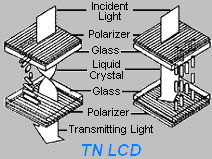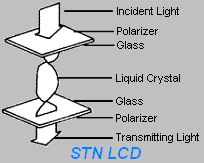
LCD Operating Modes
Twisted Nematic (TN), Super Twisted Nematic (STN), Film
Compensated STN (FSTN), and Color STN (CSTN) are the terms used to describe
four types of Liquid
Crystal Displays, each twisting the orientation of the light passing through
the Liquid Crystal Display structure differently to effect contrast and coloration. We also
compare coloration, viewing angles, and costs between the technologies.
![]() TWISTED NEMATIC (TN)
LCDs
TWISTED NEMATIC (TN)
LCDs
TN displays have a twist ( the rotation of the molecules from one
plane of the display to the other) of 90 degrees or less. All passive direct
drive , active matrix, and most passive low level (x2 to x32) multiplexed
LCD's have a 90 degree twist.
The basic Twisted Nematic (TN) LCD consists of a layer of liquid crystal
material supported by two glass plates. The liquid crystal material is a
mixture of long, cylindrically shaped molecules with different electrical
and optical properties, depending on direction
On the inner surfaces of the glass
plates are transparent electrodes, which are patterned to form the desired
visual image. The inner surfaces are coated with a polymer, which is rubbed
so that the liquid crystal material at one surface lies perpendicular to the
other. Across the film of liquid crystal, the molecules form a 90° twist.
 On
the outer surface of the glass plates, polarizers are placed so they are
parallel to the liquid crystal orientation and perpendicular to each other.
in the "off" state, light entering the first polarizer is guided by the
liquid crystal layer twist to the second polarizer, through which it is
transmitted. When the cell is energized, the LC material is aligned with the
electric field; light transmitted through the first polarizer is blocked by
the second polarizer, forming a dark image. The effect may be reversed if
the polarizers are placed parallel to each other, and a light image on a
dark background is formed
On
the outer surface of the glass plates, polarizers are placed so they are
parallel to the liquid crystal orientation and perpendicular to each other.
in the "off" state, light entering the first polarizer is guided by the
liquid crystal layer twist to the second polarizer, through which it is
transmitted. When the cell is energized, the LC material is aligned with the
electric field; light transmitted through the first polarizer is blocked by
the second polarizer, forming a dark image. The effect may be reversed if
the polarizers are placed parallel to each other, and a light image on a
dark background is formed
The TN technology comes in a single coloration, it is Black characters on a
gray background. It is the least expensive, but has the lowest visual
quality, primarily in viewing angle.
![]() SUPER TWISTED NEMATIC
(STN) LCDs
SUPER TWISTED NEMATIC
(STN) LCDs
Although Twisted
Nematic LCDs may be driven in a time multiplexed fashion to increase the
amount of information displayed, they are restricted in terms of reduced
contrast and limited viewing angle. To achieve more highly multiplexed
displays, supertwist technology is employed.
Super Twisted Nematic LCD's have a twist that is greater than
90 but less than 360 degrees. Currently most STN displays are made with a
twist between 180 and 270 degrees. The higher twist angles cause steeper
threshold curves which put the on and off voltages closer together. The
steeper thresholds allow multiplex rates greater than 32 to be achieved.
 In
this type of display, the LC material undergoes a greater than 90° twist
from plate to plate; typical values range from 180 to 270°. The polarizers
in this case are not mounted parallel to the LC at the surface but rather at
some angle. The cell, therefore, does not work on a light "guiding"
principle, as in Twisted Nematic LCDs, but instead on a birefringence
principle. The position of the polarizers, the cell thickness, and the
birefringence of the LC are carefully chosen to result in a particular color
in the "off" state. Usually, this is a yellow-green to maximize the contrast
ratio. The LC in the cell is "supertwisted" that will give it the ability to
use a high multiplex rate. As the twist is increased, the LC molecules in
the middle of the layer are aligned with the applied electric field by
smaller changes in voltage. This gives rise to a very steep transmission vs.
voltage curve, allowing up to 240-line multiplexing.
In
this type of display, the LC material undergoes a greater than 90° twist
from plate to plate; typical values range from 180 to 270°. The polarizers
in this case are not mounted parallel to the LC at the surface but rather at
some angle. The cell, therefore, does not work on a light "guiding"
principle, as in Twisted Nematic LCDs, but instead on a birefringence
principle. The position of the polarizers, the cell thickness, and the
birefringence of the LC are carefully chosen to result in a particular color
in the "off" state. Usually, this is a yellow-green to maximize the contrast
ratio. The LC in the cell is "supertwisted" that will give it the ability to
use a high multiplex rate. As the twist is increased, the LC molecules in
the middle of the layer are aligned with the applied electric field by
smaller changes in voltage. This gives rise to a very steep transmission vs.
voltage curve, allowing up to 240-line multiplexing.
The STN technology comes in two colorations, Green STN and Silver STN.
The STN-Green has Dark Violet / Black characters on a Green
background. The
STN-Silver has Dark Blue / Black characters on a Silver background.
It is in the middle of the road as far as cost, but has very good visual
quality. The contrast is similar to TN technology.
![]() Film Compensated Super
Twisted Nematic
(FSTN) LCDs
Film Compensated Super
Twisted Nematic
(FSTN) LCDs
The most recent advance has been the
introduction of Film compensated Super Twisted Nematic (FSTN) displays. This
adds a retardation film to the STN display that compensates for the color
added by the birefringence effect. This allows a black and white display to
be produced and provides for a higher contrast and wider viewing angle.
The FSTN technology comes
in a single coloration, Black characters on a White / Gray
background. Of the three
technologies listed here, it is the most expensive, but it has better
viewing angles and contrast that the STN technology listed above.